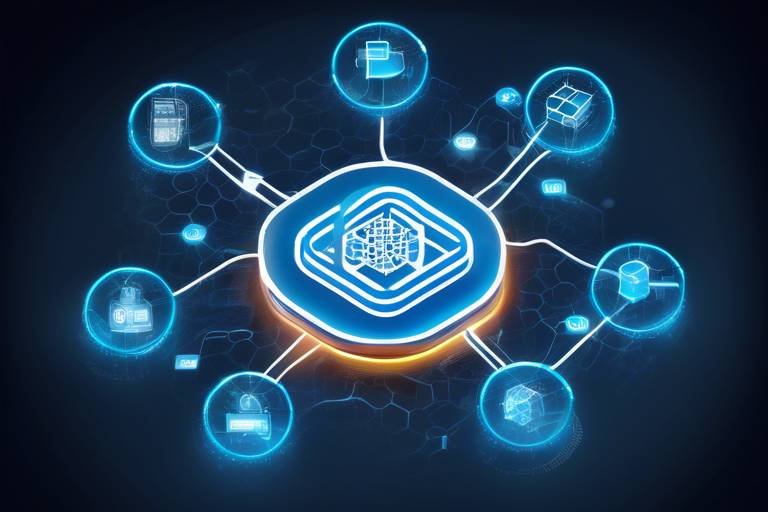Blockchain: Empowering The Internet of Things
In today's digital landscape, the intersection of blockchain technology and the Internet of Things (IoT) is creating waves of transformation across various industries. Imagine a world where devices communicate seamlessly, data is exchanged securely, and every transaction is recorded transparently. This is not just a dream; it’s the reality that blockchain is helping to build. By leveraging the decentralized nature of blockchain, we can enhance the security, efficiency, and overall functionality of IoT systems. This article dives deep into how this powerful combination is reshaping our future.
At its core, blockchain technology is a decentralized ledger system that records transactions across multiple computers. This means that no single entity has control over the entire chain, making it nearly impossible to alter any information without consensus from the network. Each block in the chain contains a list of transactions, a timestamp, and a cryptographic hash of the previous block, ensuring that all data is securely linked. This fundamental principle of transparency and immutability makes blockchain a perfect match for the IoT landscape, where trust and data integrity are paramount.
The Internet of Things is a revolutionary concept that connects everyday devices to the internet, allowing them to send and receive data. From smart home appliances to industrial machines, IoT is transforming how we interact with technology. It enables real-time data collection and analysis, leading to smarter decision-making across various sectors. For instance, in healthcare, IoT devices can monitor patient vitals and send alerts to doctors, while in transportation, connected vehicles can optimize traffic flow and reduce accidents. The possibilities are endless, and as we delve deeper into the synergy between blockchain and IoT, the potential becomes even more exciting.
Combining blockchain with IoT offers several key benefits that can revolutionize how we handle data and transactions:
- Enhanced Security: Blockchain’s decentralized nature provides a robust defense against cyber threats, making it harder for hackers to compromise IoT devices.
- Data Integrity: The immutability of blockchain ensures that the data collected by IoT devices is accurate and trustworthy.
- Smart Contracts: These self-executing contracts automate processes, reducing the need for intermediaries and enabling seamless transactions.
One of the most significant advantages of integrating blockchain with IoT is the enhanced security it provides. Traditional IoT systems often face vulnerabilities due to their centralized nature, which can be exploited by cybercriminals. However, with blockchain, each device operates on a decentralized network, making it much more challenging for attackers to manipulate data or gain unauthorized access. This ensures that user information remains confidential and secure, fostering greater trust in IoT applications.
Blockchain guarantees the authenticity of the data collected by IoT devices. Each piece of data is time-stamped and linked to its origin, creating a reliable audit trail. This feature is crucial in sectors like supply chain management, where tracking the provenance of goods is essential. By minimizing the risks of tampering or fraud, blockchain enhances the overall reliability of IoT systems, ensuring that businesses can make informed decisions based on accurate data.
While the integration of blockchain and IoT holds immense promise, it is not without its challenges. Some of the potential hurdles include:
- Scalability Issues: As the number of connected devices grows, maintaining a scalable blockchain network becomes increasingly complex.
- Energy Consumption: The energy required to maintain blockchain networks can be significant, raising concerns about sustainability.
- Interoperability: Different platforms may not easily communicate with each other, creating barriers to seamless integration.
Many industries are already reaping the benefits of combining blockchain with IoT. Here are a few noteworthy examples:
Blockchain and IoT are revolutionizing urban planning and infrastructure management. In smart cities, these technologies are used for:
- Traffic Management: Real-time data from connected vehicles can optimize traffic flow, reducing congestion.
- Energy Distribution: Smart grids can efficiently manage energy consumption and distribution, leading to more sustainable cities.
In the healthcare sector, blockchain enhances patient data management and secure sharing of medical records. IoT devices can monitor medical equipment and patient health, ensuring timely interventions. This integration ultimately improves healthcare delivery and patient outcomes, creating a more efficient healthcare system.
1. What is blockchain?
Blockchain is a decentralized ledger technology that records transactions across a network of computers, ensuring transparency and security.
2. How does IoT work?
The Internet of Things connects everyday devices to the internet, allowing them to collect and exchange data for smarter decision-making.
3. What are the benefits of combining blockchain with IoT?
The integration enhances security, ensures data integrity, and enables automated processes through smart contracts.
4. What challenges exist in implementing blockchain for IoT?
Challenges include scalability, energy consumption, and interoperability among different platforms.

Understanding Blockchain Technology
Blockchain technology is a revolutionary concept that has taken the digital world by storm. At its core, it is a decentralized ledger system that allows for secure and transparent transactions without the need for a central authority. Imagine a digital notebook that everyone can see and write in, but no one can erase or alter what has been written. This is the essence of blockchain: a permanent record that everyone can trust.
The fundamental principles of blockchain revolve around three key elements: decentralization, transparency, and security. Unlike traditional databases, which are controlled by a single entity, blockchain distributes data across a network of computers, or nodes. This means that no single point of failure exists, making it incredibly resilient against attacks. Each transaction is recorded in a block, and once a block is filled with data, it is linked to the previous block, forming a chain of blocks—hence the name "blockchain."
One of the most compelling features of blockchain is its transparency. Every participant in the network has access to the same information, which fosters a sense of trust among users. When a transaction occurs, it is verified by multiple nodes before being added to the blockchain, ensuring that the data is accurate and legitimate. This process not only enhances security but also enables traceability, making it easy to track the history of transactions.
Furthermore, blockchain employs advanced cryptographic techniques to secure the data. Each block contains a unique cryptographic hash of the previous block, along with a timestamp and transaction data. This ensures that if someone tries to alter a block, the hash will change, and everyone in the network will be alerted to the tampering. In this way, blockchain acts as a digital fortress, safeguarding information from unauthorized access and fraud.
In summary, blockchain technology is not just a passing trend; it is a foundational shift in how we think about data and transactions. Its decentralized nature, combined with transparency and security, offers a robust solution to many of the challenges faced in today’s digital landscape. As we continue to explore the intersections of blockchain and the Internet of Things (IoT), the potential for innovation and efficiency becomes even more exciting.
- What is blockchain technology? - Blockchain is a decentralized ledger system that records transactions across multiple computers, ensuring security and transparency.
- How does blockchain ensure security? - Blockchain uses cryptographic techniques and a decentralized network to protect data from unauthorized access and tampering.
- What are the benefits of using blockchain? - Key benefits include enhanced security, transparency, traceability, and reduced risk of fraud.
- Can blockchain be integrated with IoT? - Yes, the combination of blockchain and IoT can improve data integrity, security, and enable automated processes through smart contracts.

The Role of IoT in Modern Technology
The Internet of Things, commonly referred to as IoT, is not just a buzzword; it’s a revolutionary concept that’s reshaping how we interact with the world around us. Imagine a world where your refrigerator can remind you to buy milk, or your car can communicate with traffic lights to optimize your route. Sounds futuristic, right? Well, that future is here, and it’s powered by IoT technology. By connecting everyday devices to the internet, IoT enables seamless communication and data exchange, making our lives more efficient and convenient.
In modern technology, IoT plays a pivotal role across various sectors. It connects billions of devices, allowing them to collect and share data in real-time. This connectivity not only enhances operational efficiency but also facilitates smarter decision-making. For instance, in the realm of healthcare, wearable devices monitor patients' vital signs and send alerts to healthcare providers, ensuring timely interventions. In transportation, IoT sensors can track vehicle performance and optimize maintenance schedules, reducing downtime and costs.
Moreover, IoT is a game-changer in the context of smart homes. Home automation systems can control lighting, heating, and security, all from the convenience of a smartphone app. This integration not only enhances comfort but also contributes to energy efficiency, as homeowners can monitor and adjust their energy usage in real-time. Imagine being able to turn off your lights or adjust your thermostat while you're halfway across the world! This level of control is made possible by the interconnectedness of IoT devices.
However, the true magic of IoT lies in its ability to collect vast amounts of data. This data can be analyzed to uncover patterns and insights that drive innovation. For example, businesses can use IoT data to predict consumer behavior, optimize supply chains, and enhance customer experiences. It’s like having a crystal ball that helps companies make informed decisions based on real-world data.
As we embrace this technological evolution, it’s essential to recognize the challenges that come with it. While IoT offers incredible benefits, it also raises concerns regarding security and privacy. With so many devices connected to the internet, the risk of cyber threats increases. Therefore, it’s crucial for companies to implement robust security measures to protect sensitive data and maintain user trust.
In summary, the role of IoT in modern technology is transformative. It connects devices, enhances efficiency, and empowers users with valuable insights. As we continue to innovate and integrate IoT into our daily lives, the potential for growth and improvement is limitless. The question is, how will you leverage IoT to make your life easier and more efficient?
- What is IoT? - IoT stands for the Internet of Things, which refers to the network of connected devices that communicate and exchange data over the internet.
- How does IoT impact daily life? - IoT enhances daily life by enabling smart devices to automate tasks, improve efficiency, and provide real-time information.
- Are there security concerns with IoT? - Yes, the interconnected nature of IoT devices can pose security risks, making it essential to implement strong security measures.
- What industries benefit from IoT? - Industries such as healthcare, transportation, agriculture, and smart homes significantly benefit from IoT technology.

Key Benefits of Integrating Blockchain with IoT
Integrating blockchain technology with the Internet of Things (IoT) is like adding a turbocharger to an already powerful engine. The synergy between these two technologies offers a plethora of benefits that not only enhance security but also streamline operations across various industries. One of the most significant advantages is the enhanced security that blockchain provides. By utilizing a decentralized ledger, each device can communicate securely without the need for a central authority, drastically reducing the risk of cyber threats. Imagine a world where your smart home devices can interact without the fear of being hacked—this is the promise of blockchain in IoT.
Moreover, the integration leads to improved data integrity and traceability. With blockchain, every piece of data generated by IoT devices is recorded in a tamper-proof manner. This means that businesses can trust the authenticity of the information they receive, allowing for more informed decision-making. For instance, in supply chain management, blockchain can track the journey of products from manufacturer to consumer, ensuring that the data is accurate and verifiable. This level of transparency not only builds trust among stakeholders but also minimizes the risks of fraud.
Another compelling benefit is the potential for automated processes through the use of smart contracts. These self-executing contracts can automate various tasks within IoT systems, such as payments for services rendered or the execution of transactions once specific conditions are met. This automation can significantly reduce operational costs and increase efficiency. For example, in a smart energy grid, a smart contract could automatically adjust energy distribution based on real-time data, optimizing resource use and reducing waste.
Additionally, the integration of blockchain with IoT can facilitate better interoperability among different devices and platforms. As the IoT ecosystem continues to expand, having a unified system that allows devices from various manufacturers to communicate seamlessly is crucial. Blockchain can serve as a common framework that enhances collaboration among different IoT devices, thereby creating a more cohesive and efficient network.
In summary, the key benefits of integrating blockchain with IoT include:
- Enhanced Security: Protects devices from cyber threats.
- Data Integrity: Ensures the authenticity of collected data.
- Automated Processes: Streamlines operations through smart contracts.
- Interoperability: Facilitates seamless communication among devices.
As we delve deeper into this transformative technology, it's clear that the integration of blockchain and IoT is not just a trend; it's a revolution that promises to reshape industries and improve the way we interact with technology.

Improved Security and Privacy
The integration of blockchain technology with the Internet of Things (IoT) brings about a significant enhancement in security and privacy for users and devices alike. Imagine a world where your smart devices communicate seamlessly without the constant fear of data breaches or cyber threats looming over your head. Sounds like a dream, right? Well, it’s becoming a reality thanks to the unique properties of blockchain.
At its core, blockchain operates as a decentralized ledger, meaning that no single entity has control over the entire network. This decentralization is key to its security. When data is recorded on a blockchain, it is encrypted and distributed across a network of computers, making it incredibly difficult for hackers to alter or steal information. In contrast to traditional systems, where a centralized database is a prime target for cybercriminals, blockchain's distributed nature serves as a robust defense mechanism.
Moreover, every transaction on a blockchain is verified by multiple nodes before it is added to the ledger. This process not only ensures that the data is accurate but also significantly reduces the chances of fraud. Each transaction is time-stamped and linked to the previous transaction, creating an unchangeable chain of records. This is particularly beneficial for IoT devices, which often generate vast amounts of data that require secure handling.
Another crucial aspect of improved security is the use of smart contracts. These self-executing contracts with the terms of the agreement directly written into code can automate processes between IoT devices. For instance, consider a scenario where your smart thermostat communicates with your energy provider. Instead of relying on a centralized system that could be compromised, a smart contract could autonomously manage your energy consumption based on real-time data, ensuring that your information remains private and secure.
In addition to security, privacy is a major concern for users of IoT devices. With traditional systems, personal data is often stored in centralized servers, leaving it vulnerable to breaches. Blockchain technology changes the game by allowing users to maintain control over their own data. Through cryptographic techniques, users can decide who accesses their information and under what circumstances. This level of control not only enhances privacy but also builds trust between users and service providers.
However, it’s important to note that while blockchain offers significant improvements in security and privacy, it is not a silver bullet. Users must still exercise caution and adopt best practices to protect their devices and data. For instance, using strong passwords and regularly updating device software are essential steps in maintaining security.
In summary, the combination of blockchain and IoT presents a powerful solution to the pressing issues of security and privacy. By leveraging the strengths of blockchain, we can create a safer and more secure environment for our interconnected devices, allowing us to enjoy the benefits of technology without compromising our personal information.
- What is blockchain technology? Blockchain is a decentralized digital ledger that records transactions across many computers to ensure that the recorded transactions cannot be altered retroactively.
- How does blockchain improve IoT security? Blockchain enhances IoT security by decentralizing data storage, making it difficult for hackers to target a single point of failure.
- What are smart contracts? Smart contracts are self-executing contracts with the terms of the agreement directly written into code, automating processes and enhancing security.
- Can blockchain guarantee privacy? Yes, blockchain allows users to control their data and decide who can access it, significantly improving privacy.

Data Integrity and Traceability
In the rapidly evolving landscape of technology, ensuring data integrity and traceability has become paramount, especially in the context of the Internet of Things (IoT). As devices continuously collect and transmit data, the potential for inaccuracies, tampering, or outright fraud increases. This is where the integration of blockchain technology comes into play, providing a robust solution to these challenges. Blockchain operates as a decentralized ledger, which means that once data is recorded, it becomes nearly impossible to alter or delete it without consensus from the network. This feature not only enhances the authenticity of the data collected but also builds trust among users and stakeholders alike.
Imagine a scenario where a smart thermostat in your home records temperature data over time. If this data is stored on a traditional server, it could be vulnerable to hacking or manipulation. However, when this data is stored on a blockchain, each entry is time-stamped and linked to previous entries, creating a chain of custody that is transparent and immutable. This means that anyone with access to the blockchain can verify the accuracy of the data, ensuring that it reflects the true conditions of your environment.
Furthermore, the traceability provided by blockchain can be particularly beneficial in industries like supply chain management. For instance, consider a food supply chain where freshness and safety are critical. By utilizing IoT sensors to monitor conditions during transport and storing this data on a blockchain, stakeholders can trace the journey of a product from farm to table. This not only helps in identifying any points of contamination but also allows consumers to verify the origin and quality of their food. With the ability to track every step of the process, businesses can respond swiftly to any issues, thereby enhancing overall safety and consumer confidence.
The advantages of blockchain for data integrity and traceability extend beyond just verification. They also facilitate compliance with regulations. Many industries are subject to stringent data management laws, and blockchain's inherent transparency makes it easier to demonstrate compliance. For example, in the pharmaceutical industry, tracking the production and distribution of drugs is crucial to prevent counterfeit products from entering the market. By utilizing blockchain, companies can maintain an auditable trail of every transaction, ensuring that all parties involved can access accurate and tamper-proof records.
In summary, the integration of blockchain with IoT not only enhances data integrity and traceability but also fosters a culture of transparency and trust. As we move forward into an increasingly interconnected world, the importance of these features cannot be overstated. By leveraging the strengths of both technologies, industries can ensure that the data they rely on is accurate, secure, and reliable, paving the way for innovative solutions and improved outcomes across various sectors.
- What is data integrity?
Data integrity refers to the accuracy and consistency of data over its lifecycle. It ensures that data remains unaltered and trustworthy.
- How does blockchain ensure data integrity?
Blockchain ensures data integrity by creating a decentralized and immutable ledger where each transaction is recorded and cannot be changed without consensus.
- What is traceability in the context of IoT?
Traceability refers to the ability to track and verify the history, location, or application of an item through recorded data, which is crucial in supply chains and safety management.
- Why is traceability important?
Traceability is important because it helps identify sources of issues, enhances safety, and builds consumer trust by providing transparency in processes.

Challenges in Implementing Blockchain for IoT
As promising as the combination of blockchain and the Internet of Things (IoT) may seem, it doesn't come without its fair share of challenges. Integrating these two technologies is akin to trying to fit a square peg into a round hole; while they complement each other beautifully, the journey to seamless integration is anything but straightforward. One of the most significant hurdles is scalability. Blockchain networks, particularly those that utilize proof-of-work mechanisms, can struggle to handle the massive amounts of data generated by billions of IoT devices. Imagine a bustling highway during rush hour; if every car (or device) is trying to communicate at once, traffic jams are inevitable. This congestion can lead to delays in data processing, which is critical in real-time applications.
Another challenge is energy consumption. The energy required to maintain a blockchain network can be substantial, particularly for those that rely on computationally intensive consensus algorithms. This is particularly concerning when we consider the energy constraints of many IoT devices, which are often designed to be low-power. The irony is hard to ignore: while blockchain promises enhanced efficiency, its implementation can sometimes lead to increased energy demands, creating a paradox that needs to be resolved.
Furthermore, interoperability is a significant issue. The IoT landscape is fragmented, with various devices operating on different protocols and standards. For blockchain to be effective in this environment, it needs to seamlessly interact with diverse IoT systems. This lack of standardization can create barriers to communication, much like trying to have a conversation in a room full of people speaking different languages. Without a common framework, the potential of blockchain in IoT remains unfulfilled.
Lastly, there are also concerns regarding regulatory compliance. As blockchain technology evolves, so do the laws and regulations surrounding data privacy and security. Organizations looking to implement blockchain solutions must navigate this complex landscape, ensuring that they remain compliant with ever-changing regulations. Failure to do so could result in significant legal repercussions, not to mention a loss of consumer trust.
In summary, while the integration of blockchain and IoT holds immense potential, the journey is fraught with challenges that must be addressed. From scalability issues and energy consumption to interoperability and regulatory compliance, these hurdles require innovative solutions and collaborative efforts across industries. As we continue to explore this exciting frontier, overcoming these obstacles will be crucial in unlocking the full potential of blockchain-enhanced IoT applications.
- What is the main challenge of integrating blockchain with IoT? The primary challenge is scalability, as blockchain networks may struggle to handle the vast amounts of data generated by numerous IoT devices.
- How does energy consumption affect IoT devices using blockchain? Many IoT devices are low-power, and the energy requirements of maintaining a blockchain network can be substantial, leading to potential conflicts.
- Why is interoperability important in blockchain and IoT integration? Interoperability ensures that different IoT devices can communicate effectively with blockchain systems, which is crucial for realizing the full potential of these technologies.
- What regulatory concerns exist with blockchain and IoT? Organizations must navigate complex laws and regulations regarding data privacy and security, which can vary significantly across regions.

Real-World Applications of Blockchain in IoT
In today's fast-paced digital landscape, the integration of blockchain technology with the Internet of Things (IoT) is not just a trend; it's a revolutionary approach that is reshaping various industries. The synergy between these two technologies is unlocking new possibilities and driving innovation across a multitude of sectors. From enhancing supply chain management to enabling smarter cities, the applications are both diverse and impactful.
One of the most compelling examples of this integration is in the realm of smart cities. Urban areas are increasingly adopting IoT devices to monitor and manage resources more efficiently. For instance, blockchain can be utilized to track energy consumption in real-time, allowing cities to optimize energy distribution based on demand. Imagine a city where streetlights adjust their brightness based on the presence of pedestrians or vehicles, significantly reducing energy waste. By using blockchain to record and verify this data, municipalities can ensure transparency and accountability, making urban living more sustainable.
Another fascinating application lies in healthcare. The healthcare industry is notorious for its complex data management systems, often leading to inefficiencies and compromised patient privacy. By integrating blockchain with IoT devices, healthcare providers can securely share patient data across platforms while maintaining strict privacy controls. For example, wearable health devices can continuously monitor a patient's vital signs, and this data can be securely stored on a blockchain. This not only enhances patient care through real-time monitoring but also provides a robust audit trail, ensuring that the data is accurate and tamper-proof.
In the realm of supply chain management, the combination of blockchain and IoT is creating a paradigm shift. Imagine a scenario where every product can be tracked from its origin to the consumer's hands, ensuring authenticity and reducing fraud. Blockchain provides a decentralized ledger that records every transaction, while IoT devices can monitor conditions such as temperature and humidity during transportation. This is particularly crucial for perishable goods like food and pharmaceuticals, where maintaining optimal conditions is vital. With this technology, companies can not only improve efficiency but also enhance consumer trust by providing verifiable proof of product integrity.
Moreover, automotive industries are also reaping the benefits of this powerful combination. Connected vehicles equipped with IoT sensors can communicate with each other and with infrastructure to improve safety and efficiency on the roads. Blockchain can facilitate secure communication between vehicles, ensuring that data such as traffic conditions and potential hazards are shared in real-time. This can lead to smarter traffic management systems that reduce congestion and enhance the overall driving experience.
As we explore these real-world applications, it becomes clear that the integration of blockchain and IoT is not just about technological advancement; it's about creating a more efficient, secure, and transparent world. The potential is vast, and as these technologies continue to evolve, we can expect to see even more innovative solutions that address some of the most pressing challenges of our time.
- What is the main benefit of combining blockchain with IoT?
The primary benefit is enhanced security and data integrity, ensuring that information exchanged between devices is secure and trustworthy. - How does blockchain improve supply chain management?
Blockchain provides a transparent and immutable record of transactions, allowing for real-time tracking of products and reducing the risk of fraud. - Can blockchain help in healthcare?
Yes, blockchain can enhance patient data management by ensuring secure sharing of medical records and improving monitoring of medical devices. - What challenges exist in implementing blockchain for IoT?
Challenges include scalability issues, energy consumption, and the need for interoperability among different systems.

Smart Cities and Infrastructure
In today's fast-paced world, the concept of smart cities is gaining traction as urban areas strive to enhance the quality of life for their inhabitants. Imagine a city where traffic flows seamlessly, energy consumption is optimized, and public services are delivered efficiently—all made possible through the integration of blockchain technology and the Internet of Things (IoT). This combination not only promotes sustainability but also empowers citizens to engage with their environment in innovative ways.
At the heart of smart cities lies a network of interconnected devices, from traffic lights to waste management systems, all collecting and sharing data in real time. By leveraging blockchain, these devices can communicate securely and transparently, eliminating the risk of data tampering and ensuring that the information shared is authentic and reliable. For instance, consider how traffic management systems can utilize IoT sensors to monitor vehicle flow and adjust traffic signals accordingly. By integrating blockchain, this data can be securely recorded, creating a transparent history of traffic patterns that city planners can analyze to make informed decisions.
Moreover, the use of blockchain in smart cities enhances energy distribution. With renewable energy sources like solar panels becoming more prevalent, blockchain can facilitate peer-to-peer energy trading. Homeowners with excess energy can sell it directly to their neighbors, creating a decentralized energy market that promotes sustainability. This not only reduces reliance on traditional energy grids but also empowers communities to take control of their energy consumption.
Another significant aspect of smart cities is the improvement of public safety. With IoT devices deployed throughout urban areas, city officials can monitor everything from air quality to crime rates. By employing blockchain technology to secure this data, cities can ensure that information is accurate and accessible, allowing for timely interventions. For example, if a spike in crime is detected in a particular neighborhood, authorities can respond more quickly, deploying resources where they are needed most.
To illustrate the transformative impact of blockchain on smart cities, let's take a look at a few key areas:
| Area | Impact of Blockchain and IoT |
|---|---|
| Traffic Management | Real-time data sharing leads to optimized traffic flow and reduced congestion. |
| Energy Distribution | Facilitates peer-to-peer energy trading, promoting renewable energy usage. |
| Public Safety | Enhances data accuracy for quicker response times to incidents. |
| Waste Management | IoT sensors can optimize collection routes, reducing costs and environmental impact. |
As we move forward, the integration of blockchain and IoT will continue to redefine the landscape of urban infrastructure. The potential for enhanced efficiency, improved transparency, and greater citizen engagement is immense. However, it is essential to address the challenges that come with this integration, such as scalability and interoperability, to fully realize the benefits of smart cities.
- What is a smart city? A smart city uses technology and data to improve the quality of life for its residents, making urban areas more efficient and sustainable.
- How does blockchain enhance smart cities? Blockchain provides a secure, transparent way to share data among interconnected devices, ensuring authenticity and reliability.
- What are some examples of blockchain applications in smart cities? Examples include optimized traffic management, peer-to-peer energy trading, and improved public safety monitoring.
- What challenges do smart cities face? Challenges include scalability issues, energy consumption, and the need for interoperability among different technologies.

Healthcare Innovations
The healthcare industry is undergoing a remarkable transformation, and at the heart of this revolution is the powerful combination of blockchain technology and the Internet of Things (IoT). Imagine a world where your medical records are not only secure but also easily accessible whenever you need them. This is becoming a reality, thanks to the innovative applications of these technologies. With IoT devices continuously collecting data—from vital signs to medication adherence—blockchain ensures that this data remains secure and trustworthy.
One of the most significant breakthroughs in healthcare is the ability to share patient data seamlessly across different platforms while maintaining privacy and security. For instance, consider a patient who visits multiple specialists. Traditionally, each doctor would have their own records, leading to fragmented information and potential errors. However, with blockchain, all of a patient's health data can be stored in a single, immutable ledger. This not only improves collaboration among healthcare providers but also enhances the overall quality of care.
Moreover, the integration of blockchain with IoT devices can streamline the monitoring of medical devices. Imagine a scenario where a patient has a wearable device that tracks their heart rate. This device can send real-time data to healthcare providers, who can then use blockchain to verify and store this information securely. If any irregularities are detected, doctors can respond promptly, potentially saving lives. This level of real-time monitoring and data security can lead to more proactive healthcare interventions.
Furthermore, the use of smart contracts—self-executing contracts with the terms of the agreement directly written into code—can automate various processes in healthcare. For example, smart contracts can facilitate automatic payments for services rendered, ensuring that healthcare providers are compensated promptly and accurately. This not only improves operational efficiency but also reduces administrative overhead, allowing healthcare professionals to focus more on patient care rather than paperwork.
In addition, blockchain can enhance the integrity of clinical trials. By providing a transparent and tamper-proof record of trial data, it ensures that results are credible and can be trusted by regulatory bodies and the public alike. This is crucial for advancing medical research and developing new treatments. The combination of IoT and blockchain can also help track the supply chain of pharmaceuticals, ensuring that medications are authentic and have been stored under the right conditions, thereby reducing the risk of counterfeit drugs.
As we look to the future, the potential for blockchain and IoT in healthcare is virtually limitless. With continuous advancements in technology, we can expect to see more innovative solutions that not only improve patient outcomes but also transform the healthcare landscape as a whole. The synergy between these two technologies heralds a new era of efficient, secure, and patient-centered healthcare.
- How does blockchain improve patient data security? Blockchain provides a decentralized and immutable ledger, ensuring that patient data is secure and cannot be altered without detection.
- What role do IoT devices play in healthcare? IoT devices collect real-time health data, enabling continuous monitoring and timely interventions by healthcare professionals.
- Can blockchain help in reducing healthcare costs? Yes, by streamlining processes and reducing administrative burdens, blockchain can lead to significant cost savings in the healthcare sector.
- Are there any challenges in implementing blockchain in healthcare? Yes, challenges include scalability, regulatory compliance, and the need for interoperability among different healthcare systems.
Frequently Asked Questions
- What is blockchain technology?
Blockchain technology is a decentralized digital ledger that records transactions across many computers in a way that ensures the security and transparency of the data. This means that once a transaction is recorded, it cannot be altered without the consensus of the network, making it highly reliable.
- How does blockchain enhance the Internet of Things (IoT)?
By integrating blockchain with IoT, we can achieve enhanced security, data integrity, and automation through smart contracts. This combination allows devices to communicate more securely, ensuring that data exchanged between them remains confidential and tamper-proof.
- What are the key benefits of using blockchain in IoT applications?
Some key benefits include improved security against cyber threats, enhanced data integrity through reliable audit trails, and the potential for automating processes which can lead to increased efficiency across various industries.
- Are there any challenges in implementing blockchain for IoT?
Yes, there are several challenges, including scalability issues, high energy consumption, and the need for interoperability between different blockchain and IoT platforms. These hurdles need to be addressed to fully leverage the potential of this technology.
- Can you give examples of real-world applications of blockchain in IoT?
Absolutely! In smart cities, blockchain and IoT are used for efficient traffic management and energy distribution. In healthcare, they help in secure sharing of medical records and monitoring devices, ultimately improving patient care and outcomes.
- How does blockchain improve security and privacy in IoT?
Blockchain's decentralized nature protects IoT devices from cyber threats by distributing the data across a network rather than storing it in a single location. This makes it harder for hackers to access sensitive information, ensuring user privacy is maintained.
- What is the significance of data integrity in IoT?
Data integrity in IoT is crucial because it ensures that the information collected by devices is authentic and reliable. With blockchain, any data transmitted can be verified and traced back to its source, minimizing risks of tampering or fraud.



















